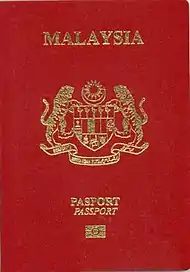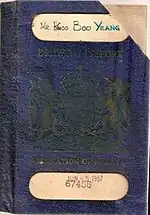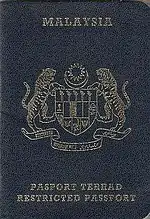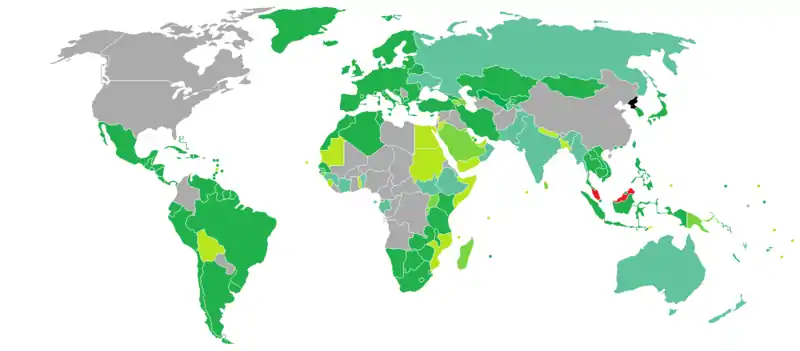Malaysian passport
The Malaysian passport (Malay: Pasport Malaysia) is the passport issued to citizens of Malaysia by the Immigration Department of Malaysia.
| Malaysian passport Pasport Malaysia | |
|---|---|
 The front cover of a contemporary Malaysian biometric passport. | |
| Type | Passport |
| Issued by | |
| First issued | 1 March 1958 (first version)[1] March 1998 (biometric passport) 2 February 2010 (ICAO Compliant) 15 November 2017 (current update)[2] |
| Purpose | Identification |
| Eligibility | Malaysian citizenship |
| Expiration | 5 years from date of issue |
| Cost |
|
The main legislation governing the production of passports and travel documents, their possession by persons entering and leaving Malaysia, and related matters is the Passport Act 1966.
Processing of Malaysian passport applications and renewals is very rapid, with new passports usually issued one hour after payment for normal cases.[3] The introduction of passport renewal kiosks (KiPPas) at Immigration Department branches across the country allow passport applicants to apply and pay for their passports without queuing at the passport application counters.[4]
Biometric passport

Malaysia was the first country in the world to issue biometric passports in March 1998, after a local company, IRIS Corporation, developed the technology.[5] In December 2002, thumbprint data was added to the biometric data on the passport chip. Similar technology is used in the Malaysian identity card, MyKad.
The biometric data included on the Malaysian passport is a digital photograph of the bearer's face, and images of their two thumbprints. Malaysian immigration checkpoints were the only ones with the technology to read and authenticate the data from the RFID chip using a fingerprint scanner and facial recognition technology, but widespread adoption of ePassport technology around the world has seen the technology installed in international airports in the US, the UK and other countries.
In addition to biometric data and the personal information stored on the information page, the chip also records the bearer's travel history of the last ten entry and exits at Malaysia border control points.
Concern about possible "cloning" of the data from the passport chip for the purposes of identity theft prompted IRIS to issue a press release in 2006, stating that the chip and data had never been successfully cloned, and that digital keys stored on each chip made such duplication and forgery impossible.[6]
On 2 February 2010, Malaysia started issuing ICAO compliant e-Passports, valid for five years or two years. It was the 75th nation in the world to adopt the ICAO standard. The implementation of the new passport began at offices across Klang Valley, Johor and Pahang before expanding nationwide between March and May 2010 and to foreign missions abroad between July and August 2010.
Types of Malaysian passports
In Malay language, the name were formerly designated 'Paspot Malaysia', but the spelling was changed to 'Pasport Malaysia' in the 1980s.
Regular international passport

The regular international passport (Malay: pasport antarabangsa) is the ordinary passport issued to Malaysian citizens for international travel. It features a red cover.
The regular international passport has incorporated biometric features since 1998. The biometric passport contains an 8 kB microchip which was developed by a Malaysian technology firm, IRIS Corporation. In February 2010, the passport was updated to comply with the ICAO standard on biometric and machine-readable passports, while the pages in a 32-page passport was increased to 48 pages. Beginning April 2013, the passport underwent another round of updating by introducing a polycarbonate sheet that holds the passport bearer's information. The information is laser engraved into the polycarbonate sheet for added security, including a hologram mini-photo of the passport bearer. With this the passport now holds 50 pages instead of 48 pages. There is no more 64 pages option since 2011. A redesign of the passport's interior pages along with new security features was launched on 15 November 2017.[7]
A 50-page ICAO e-passport valid for five years costs RM200. Senior citizens, children below 12 years old, Hajj pilgrims, and students below 21 years old with proof to study abroad are entitled to half price from normal price. Disabled people are entitled to have their passports issued free of charge.
Previously, a 50-page ICAO e-passport valid for two years was available for RM100. On 15 January 2015, the two-year passport option was scrapped in conjunction with the announcement that reduced the normal five-year passport issuance fee from RM300 to RM200.[8]
The passport is also used by citizens from Peninsular Malaysia to enter the East Malaysian states of Sabah and Sarawak, as these two states have autonomy in immigration affairs. However, citizens travelling directly from Peninsular Malaysia may produce a Malaysian identity card, or birth certificate for children below 12 years, obtain a special immigration printout form (Document in Lieu of Internal Travel Document, IMM.114) at immigration counters for social/business visits up to 3 months, and keep the form until departure.[9]
Restricted passport

The restricted passport (pasport terhad) is issued to Malaysian citizens for travel to a specific country only. It has a blue cover.
Currently, only a restricted passport for travel to Brunei is issued.[10] Malaysian citizens residing in the East Malaysian areas of Sarawak, Sabah and Labuan are eligible to apply for the restricted passport. The passport is valid for five years and costs RM50.
Historically, Singapore permitted Malaysian citizens to utilize restricted passports, specifically for travel to Singapore. This restricted passport facility was terminated by the Government of Singapore, on the 1st of November, 2006.[11]
Official passport
The official passport (pasport rasmi) is issued exclusively to Malaysian government officials travelling on official business. It is issued by the Immigration Department of Malaysia upon request through the Ministry of Foreign Affairs (Wisma Putra).
Diplomatic passport
The diplomatic passport (pasport diplomatik) is issued to diplomatic officers.
Discontinued passport types
Previously, a restricted passport was issued for travel to Singapore. From 1 January 2005, the Immigration Department stopped issuing and renewing the restricted passport to Singapore, with existing passports to remain valid until 31 December 2006. However, as Singapore requires travel documents to be valid for a minimum of six months, Singapore announced it would stop accepting Malaysian restricted passports from 1 July 2006. Following a meeting between the home affairs ministers of both countries, Singapore agreed to extend the deadline to 1 November 2006.[12] Malaysian citizens travelling to Singapore now require the regular international passport. The green cover Hajj passport (pasport haji) was formerly issued to Malaysian Muslim citizens for a Hajj pilgrimage to Mecca, Saudi Arabia. Applications were made through Tabung Haji, the Malaysian Hajj pilgrims fund board. Hajj passports were discontinued in 2009 and pilgrims now use the regular international passport.
The British-era Federation of Malaya passports were issued when Malaysia was Malaya and under British rule.
Passport note
The passports contain a note, written in Malay and English, from the issuing state that is addressed to the authorities of all other states, identifying the bearer as a citizen of that state and requesting that he or she be allowed to pass and be treated according to international norms. In Malay, the note inside Malaysian passports reads:
| Bahawasanya atas nama Seri Paduka Baginda Yang di-Pertuan Agong Malaysia, diminta semua yang berkaitan supaya membenarkan pembawa pasport ini melalui negara berkenaan dengan bebas tanpa halangan atau sekatan dan memberikan sebarang pertolongan dan perlindungan yang perlu kepadanya. |
and in English, the note reads:
| This is to request and require in the Name of His Majesty the Yang di-Pertuan Agong of Malaysia, all whom it may concern to allow the bearer of this passport to pass freely without let or hindrance, and to afford the bearer such assistance and protection as may be necessary. |
Languages
The data page/information page are printed in Malay and English.
Identity information page
The Malaysian passport includes the following data:
- Type/Jenis ('P' for Passport)
- Country code/Kod Negara ('MYS' for Malaysia)
- Passport number/Nombor Pasport
- Name of bearer/Nama (see below for details of the naming scheme)
- Nationality ('Malaysia')
- Identity number (see below for more information) or Birth certificate number (for minors under 12 only)
- Place of birth (State of birth for citizens born in Malaysia)
- Date of birth (in DD-MMM-YYYY format, such as 24-JUN-1988)
- Sex ('M' or 'F')
- Date of issue (in DD-MMM-YYYY format)
- Date of expiry (in DD-MMM-YYYY format, 5 years from date of issue, or a maximum of 5 years 6 months for renewals)
- Issuing office
- Height/Tinggi (in centimetres)
Passport number
The passport number is the serial number that uniquely identifies a passport. The passport number changes every time a person is issued a new passport, with the previous passport number noted in an endorsement on the last page of the new passport.
The passport number is alphanumeric, with a letter followed by an eight-digit number, e.g. A00000000. The letter prefix depends on the residency status of the bearer: "A" for Peninsular Malaysia and Labuan, "H" for Sabah and "K" for Sarawak. From 1964 to 1965, when Singapore was a part of Malaysia, Singapore citizens were issued Malaysian passports with the prefix "E".[13]
Naming scheme
Due to Malaysia's heterogeneous ethnic demographic, including substantial Chinese and Indian minorities as well as Malays, the name of the bearer on the Malaysian passport is displayed using that person's customary naming practice as it is on the person's identity card (MyKad) or birth certificate (with exception of ethnic Indian and Thai names). Surname and given name fields are not differentiated on the passport, and this can cause difficulties or confusion in some countries as the placement of the surname is not consistent.
Technically speaking, every Malaysian name regardless of the ethnicity is of this type: SURNAME, FIRST NAME UNKNOWN (FNU) when only the Machine Readable Zone area of the Passport Biodata Page is considered. There is no '<<' to isolate what is technically a 'Surname' from the 'Given Name' (Please note that ICAO standards require that the name that immediately follows the three-letters country code in the Machine Readable Zone (MRZ) to be the surname of the passport holder). When swiped at international airports for border security purposes, for example: the Advanced Passenger Information System (APIS) for countries such as Australia, New Zealand and United States, the name of a Malaysian passport holder in its entirety will be captured in the 'Surname' field of the border security system, and this can sometimes cause a mismatch with how the passport holder's name is captured in the country of destination's visa system or electronic travel authority protocol. Examples of Malaysian names as printed on the Machine Readable Zone (MRZ) of the passport:
- P<MYSALI<AKBAR<BIN<MOHAMAD< (for ALI AKBAR BIN MOHAMAD)
- P<MYSDAVID<WONG<KIM<SIONG< (for DAVID WONG KIM SIONG)
- P<MYSMEGAT<HASAN<BIN<MEGAT<TERMIZI< (for MEGAT HASAN BIN MEGAT TERMIZI)
- P<MYSSUGUMARAN<SIVANATHAN< (for SUGUMARAN A/L SIVANATAN)
- P<MYSFATIMAH<BINTI<HUSIN< (for FATIMAH BINTI HUSIN)
- P<MYSJOHN<ANAK<LANGKAU< (for JOHN ANAK LANGKAU)
- P<MYSSTANLEY<BIN<JOSEPH< (for STANLEY BIN JOSEPH)
- P<MYSSIVASANGEETHA<SIVASANGEETHA<THANABALAN< (for SIVASANGEETHA A/P THANABALAN)
- P<MYSABDUL<AZIZ<RAHMAN<KHAN<BIN<SULTAN<KHAN (for ABDUL AZIZ RAHMAN KHAN BIN SULTAN KHAN)
- P<MYSWONG<KIM<SIONG< (for WONG KIM SIONG)
As can be seen from the above examples, it's evident that a name in a Malaysian Passport technically does not contain 'Given Name(s)' because '<<' is not used at all to isolate Surname from Given Names. Now, compare how a name is recorded in the Australian Passport:
The Australian Passport also does not explicitly differentiate 'Surname' from 'Given Name'. However, the Machine Readable Zone (MRZ) is very clear as regards to the passport holder's Surnames. Examples of Australian names as printed on the Machine Readable Zone (MRZ) of the passport:
- P<AUSSMITH<<JOHN<WILLIAM< (for John William SMITH)
- P<AUSIBRAHIM<<JOHN<AHMED< (for John Ahmed IBRAHIM)
- P<AUSWONG<<PHILLIPA<SIEW<MEI< (for Phillipa Siew Mei WONG)
- P<AUSMALOUF<<DAVID<ISAAK< (for David Isaak MALOUF)
- P<AUSMORAN<<EVELYN<LILY<ELIZABETH< (for Evelyn Lily Elizabeth MORAN)
- P<AUSRIZZI<<PAULO<ANTONIO (for Paulo Antonio RIZZI)
- P<AUSVAN<DER<BERGH<<JOHN<DAVID< (for John David VAN DER BERGH)
- P<AUSABU<HASSAN<<SAEMAN<NGASRI (for Saeman Ngasri ABU HASSAN)
- P<AUSSUPARMAN<<HARYANTO<WIRA< (for Haryanto Wira SUPARMAN)
- P<AUSKIM<<BAE<JYEON< (for Bae Jyeon KIM)
Notes: 'P' stands for Passport. 'MYS' and 'AUS' stand for Malaysia and Australia respectively in the Machine Readable Zone. For clarity: Surnames in block letters and Given Names in title case for examples of Australian names.
- Indian and Thai names: On the national identity card MyKad and birth certificates, Indian and Thai names are generally in the format "X A/L Y" or "X A/P Y" where 'A/L' stands for 'anak lelaki' (Malay for 'son of') and 'A/P' stands for 'anak perempuan' (Malay for 'daughter of'). On the passport detail page, the "A/L" or "A/P" designation is omitted. However, the bearer's full name as on his/her MyKad is noted on the observation page.
- Chinese names: Can be listed in three ways according to the individual's preference: surname first as is customary (surname first, then Chinese given names: "WONG Kim Siong"), surname between given names (non-Chinese derived name, surname, Chinese given names: "David WONG Kim Siong"), or in the Western style of surname last (David WONG)
- Malay names: Generally in the format "X BIN/BINTI Y", where 'BIN' means 'son of' and 'BINTI' means 'daughter of', similar to the Arabic name system. This practice is not limited to Muslim Malays however, and can also be found in Christian indigenous Sabahans and Melanaus of Sarawak.
- Native Sarawakian and Orang Asli names: Generally in the format "X ANAK Y" or "X AK Y" where 'Anak' or 'AK' means 'child of'. 'AK' abbreviation for 'ANAK'
- Western/European names: Eurasian Malaysians, or those descended from British, Portuguese or Dutch settlers, have the person's hereditary surname last ("Robert SMITH").
Identity number
The Malaysian identity number is a unique ID number allocated to each Malaysian, and is the same number on the bearer's MyKad, the Malaysian national identity card. The number is in the following format:
YYMMDD-BP-###G
- The first six digits (YYMMDD) are the date of birth of the holder, so for example 24 June 1988 would be represented as 880624.
- The next two digits (BP) are the numeric code indicating the state or country of birth.
- The last four digits are randomly generated serial numbers, and the last digit (represented above by 'G') is a gender indicator: an odd number for males and an even number for females.
On the passport information page, the identity number is written without hyphens, e.g. YYMMDD-BP-###G is written as YYMMDDBP###G.
Visa requirements

Visa requirements for Malaysian citizens are administrative entry restrictions by the authorities of other states placed on citizens of Malaysia. As of 1 January 2021, Malaysian citizens had visa-free or visa-on-arrival access to 178 countries and territories, ranking the Malaysian passport the 14th most powerful in the world (tied with Liechtenstein passport), the 2nd highest-ranked passport in Southeast Asia after the Republic of Singapore, and the 4th highest-ranked in Asia, according to the Henley Passport Index.[14] Additionally, Arton Capital's Passport Index ranked the Malaysian passport 20th in the world in terms of travel freedom, with a visa-free score of 101 countries & territories due COVID-19 pandemic travel restrictions, as of January 2021. [15]
Israel
As Malaysia does not recognise nor have diplomatic relations with the state of Israel,[16] Malaysian passports bear the inscription: "This passport is valid for all countries except Israel". Israeli passport holders are not permitted to enter Malaysia without written permission from the Malaysian Ministry of Home Affairs.
Officially, the Malaysian government allows Christians to visit Israel for religious purposes. In 2009, the government imposed a ban on visits to Israel, ostensibly due to heightened security risks posed by the Israeli–Palestinian conflict.[17] The ban was lifted in 2011, albeit with restrictions such as a quota of 700 pilgrims per year with not more than 40 pilgrims per church group, and pilgrims must be at least 18 years old and not visiting Israel more than once every three years with each stay a maximum of 10 days.[18] On 20 December 2013, the government announced a relaxation of the ban, which lifted most of the restrictions while increasing the maximum duration of stay to 21 days, subject to the security situation in Israel.[18]
However, the restrictions imposed by the Malaysian government do not prevent Israel from issuing visa on a separate sheet of paper to Malaysian citizens for entering Israel, and Malaysians are known to have visited Israel with or without permission from the Malaysian government.
North Korea
In September 2017, Malaysia announced a ban on all Malaysian citizens from travelling to North Korea, in the wake of strained Malaysia–North Korea relations following the assassination of Kim Jong-nam at Kuala Lumpur International Airport.[19]
Former restrictions
Previously, Malaysian passports were not valid for travel to various communist countries, and South Africa due to its apartheid system. Following the fall of communism in Eastern Europe and improving ties with the remaining communist countries, as well as the end of apartheid in 1994, the countries were removed from the list.
References
- "Federation of Malaya 1957 — 1963". PaperToTravel.com. 15 July 2018. Retrieved 15 July 2018.
- "Malaysia International Passport - Model K : ICAO Biometric ePassport 2017". PaperToTravel.com. 22 August 2019. Retrieved 22 August 2019.
- "Client Charter: Passport And Travel Documents". Immigration Department of Malaysia. 6 April 2012. Archived from the original on 31 October 2014. Retrieved 31 October 2014.
- One-hour passport renewal for Kuching folk, Borneo Post, 2 October 2010.
- Hsu Chuang Khoo: Malaysia's Iris may benefit from U.S. passport law Archived 29 September 2006 at the Wayback Machine, Yahoo! India News, 19 May 2006.
- Malaysia Passport Anti-Cloning Statement Archived 13 December 2006 at the Wayback Machine (PDF), IRIS Corporation Berhad, 2006.
- "New-look passport prettier and safer, too". The Star. Petaling Jaya, Malaysia. 2 December 2017. Retrieved 28 February 2018.
- Bedi, Rashvinjeet S. (15 January 2015). "Passport fee reduced to RM200". The Star (Malaysia). Retrieved 15 January 2015.
- Document In Lieu of Internal Travel Document IMM.114 Archived 18 August 2010 at the Wayback Machine, Immigration Department of Malaysia
- "Pasport Terhad ke Brunei (Restricted Passport to Brunei)". Immigration Department of Malaysia. Retrieved 28 February 2018.
- "Restricted passport invalid on Nov 1 | The Star Online". www.thestar.com.my. Retrieved 4 February 2020.
- "Restricted passport invalid on Nov 1". The Star. Petaling Jaya, Malaysia. 28 October 2006. Retrieved 28 February 2018.
- "History of Travel Documents & Passes". Singapore: Immigration and Checkpoints Authority. Archived from the original on 25 June 2014. Retrieved 21 June 2014.
- "Henley Passport Index" (PDF). www.henleypassportindex.com. Retrieved 16 February 2019.
- https://www.passportindex.org/byRank.php
- Yegar, Moshe. "Malaysia: Anti-Semitism Without Jews", "Institute for Global Jewish Affairs", October 2006, retrieved 11 April 2011.
- "Christians upset by Putrajaya curbs on Jerusalem pilgrimage" Archived 16 July 2014 at the Wayback Machine, The Malaysian Insider, 6 July 2012
- "Government relaxes Israel travel ban", The Star, 20 December 2013
- "Rising tension spurs Malaysia to ban travel to North Korea". Reuters. 28 September 2017. Retrieved 3 March 2018.
External links
- Immigration Department of Malaysia: Malaysian Passports (in English)
- Malaysian Passport Processing Office Overseas
- Security Document World: Technical specifications for the Malaysian biometric passport
- Wikivisa: Malaysia
- Images of a 1963 Federation of Malaya passport from www.passportland.com
- Passport from Federation of Malaya (1962) from www.PaperToTravel.com
- Passport from Federation of Malaya (1965) from www.PaperToTravel.com
- Passport from Malaysia - Series III (1984-1989-1993) from www.PaperToTravel.com
- Passport from Malaysia - Non-ICAO Biometric Passport, First Generation (2009-2014) from www.PaperToTravel.com
- Passport from Malaysia - Non-ICAO Biometric Official Passport (2007) from www.PaperToTravel.com
- Passport from Malaysia - Biometric ICAO ePassport (2013-2015) 2-Year Validity from www.PaperToTravel.com
- Passport from Malaysia - Biometric ICAO ePassport (2018) New Design from www.PaperToTravel.com